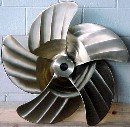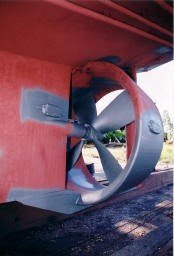Propeller
How Propellers Work
Like many aspects of ship design, designing propellers is a mixture of science and art in the form of experience. There is a lot going on at the stern of a ship that is poorly understood. This is not surprising. Every hull form, engine-propeller combination, interaction with the rudder wake region, and sea condition is different. Wave action introduces a random vertical moment into this equation.
For these reasons, most ship propellers operate at efficiencies around 56%percent, with the principle design problem being cavitation as rotational speed is increased. In comparison, aircraft propellers operate at 90% efficiency. On a ship a propeller efficiency of less than 50% indicates a poor propeller/hull design. Aviation Online Magazine describes basic propeller principles. [1]
(Efficiency is measured as a ratio of the propulsive energy produced to the energy consumed in rotating the propeller shaft.)
AAmpere (amp), SI unit of electrical current propeller works by accelerating a mass of water. This generates an equal and opposite reaction in the propeller/shaft/engine assembly. This is the thrust that drives the boat forward. In short, the propeller pushes the engine which is solidly attached to the hull – more about this poor state of affairs later.
When the propeller turns it accelerates a column of water through the screw. The pitch of the screw determines the acceleration and the distance travelled for each turn. In essence, this is like a nut turning on a screw. Increasing the pitch increases the weight of water moved and the horsepower required.
Since for efficiency a displacement boat should not exceed its hull speed (a function of the waterline length), and a propeller cannot exceed the available space under the stern, a propeller must be designed for the hull and the amount of thrust it must impart to overcome friction at the maximum hull speed.
Arbitrarily increasing the speed of the propeller or making it larger without changing the design of the screw will not make the boat go faster. Indeed, at some faster rotational speed, the water around the blades cavitates excessively, and the boat will go slower.
Cavitation is the formation of a vacuum along parts of the blade. This lowers the vapour pressure of the water, causing air bubbles to form, just like in boiling water. This causes slip, loss of efficiency and pitting of the metal. Increasing the pitch of a propeller also increases its propensity for cavitation.
Consistency (accuracy) in pitch and camber are important to reduce the potential for cavitation. This also reduces vibration: as much as 80% of hull vibration can be caused by a propeller. Propellers should be balanced both statically and dynamically.
Fixed propellers are the most efficient, strongest and least expensive. But they are at their most efficient only at their designed rpmRevolutions per minute and hull speed. At other speeds, their efficiency falls off. A fixed propeller is ideal for a boat that cruises long distances at a constant speed. Boats that stop and start a lot or change speed frequently are better with a controllable-pitch propeller.
Number of Blades
The ideal propeller has one large blade, but this would be very unstable. It would set up a lot of vibration in the shaft. Traditionally, trawler propellers were three-bladed. Modern propellers are four, five, six and seven-bladed designs. Six-bladed propellers, at first, were unsuccessful. Prior to the development of thrust systems, submarines were using designs with seven skewed (curved) blades. Generally, trawler blades are an aerofoil shape called BBeam.Troost.[2][3][4]
With more blades, vibration and noise are reduced, and thrust is more evenly distributed. For example, a boat with 200 shaft horse-power and three blades has 66.6 hphorsepower per blade. With five blades, the power distribution is 40 hp per blade. With more blades, a propeller can be smaller. However, larger propellers are better at moving water. Small blades move less water. To compensate, they have to turn faster. But increasing rpm reduces efficiency. Other factors also come into play. For example, higher block coefficients in the hull design reduce propeller efficiency.

Again, like so many boat design issues, the optimum is a compromise between several factors. Generally, the choice is between large slow turning and small fast turning propellers with an increased pitch angle.
Experience shows that the optimum for a single-screw boat is a four-bladed propeller with some skew, to compensate for the disturbed inflow. A four-bladed propeller may, however, increase sympathetic vibration, pushing you back to re-considering three or maybe five blades.
A double-screw boat is better with two smaller three-bladed propellers turning slightly faster. Propellers for nozzles should be square-tipped Kaplan designs. All propellers should be manufactured to ISO 484 Class 1 standards.
Victoria Propeller Ltd. has an online calculator for propeller size for displacement and semi-displacement hulls.
Controllable Pitch Propellers
The pitch of a propeller can be fixed-true, fixed-variable, flexible or controlled. Think of pitch as the number of threads per inch on a screw. Fixed propellers have a fixed (true) or variable pitch from the tip of the blades to the hub. A fixed-pitch propeller has a constant pitch at any radius from the hub to the tip. Think of this as a screw with a constant number of threads per inch.
A variable-pitch propeller has a pitch that increases from the hub to the tip, but is still fixed in the metal. Think of this as a variable number of threads per inch, i.e., the threads are getting further and further apart. Variable pitch propellers reduce cavitation and are used on high-speed boats, or on very large boats to compensate for varying inflow velocities due to the draft of the hull.
Flexible-pitch (pitch-adapting) propellers are made of a metal hub with carbon-fibre composite blades inserted. The blade pitch angle adapts as the load on the blade changes, reducing cavitation and increasing hydrodynamic efficiency by around 15%.[5] Designed initially for high-end yachts, they are being tested starting in 2004 in larger sizes for the US Navy.
A controllable-pitch propeller has blades whose pitch angle can be adjusted mechanically while the propeller is turning. This requires a special hollow propeller shaft for the mechanical bits. This means the engine can run at its optimum rpm all the time. To speed up, or slow down, you change the pitch of the propeller. To go from forward to reverse, you simply reverse the pitch of the blades.
Controllable-pitch propellers yield the best overall fuel economy when vessel speeds vary. They are also an advantage in areas like Europe where fuel costs are higher. When vessel speed is constant most of the time, a fixed-pitch one is better because of the reduced complexity and cost.
Kort/Rice Nozzles
When a blade rotates in water, it creates a high-pressure behind the blades and low pressure in front (towards the hull). This differential provides thrust. However, at the edge of the blades, high pressure leaks to the low-pressure side, resulting in loss of thrust.

In the 1930s, this caught the attention of Ludwig Kort, an aeronautical engineer from Hanover. He developed nozzles (shrouds or ducts) for propellers. They prevented water from escaping from the blade tips. This improved propulsion efficiency at speeds under 10 knots.
Decreasing the exit side of the shroud, thus forcing the water to accelerate as it exited the propeller, made further improvements to the Kort nozzle. Eventually, several types of Kort nozzle were developed, with the Type 19 most suited to a trawler. Today, many companies make Kort Nozzles.
Later, the Mexican company Rice Propulsion improved on the Kort nozzle by using aerodynamic duct shapes derived from wing sections displaying the highest lift and lowest drag.
References
- ↑ http://avstop.com/ac/flighttrainghandbook/basicpropellerprinciples.html
- ↑ http://traktoria.org/files/personal_submarine/propulsion/propeller/lecture_notes/hydrodynamic_characteristics_of_propellers.pdf
- ↑ Basic Ship Propulsion, Allied Publishers, 2004
- ↑ Marine Propellers and Propulsion, John Carlton, Butterworth-Heinemann, Nov 23, 2012
- ↑ A.I.R. Fertigung-Technologie GmbH, http://www.air-composite.com/englisch/html/unter/frameset_unternehmen.html